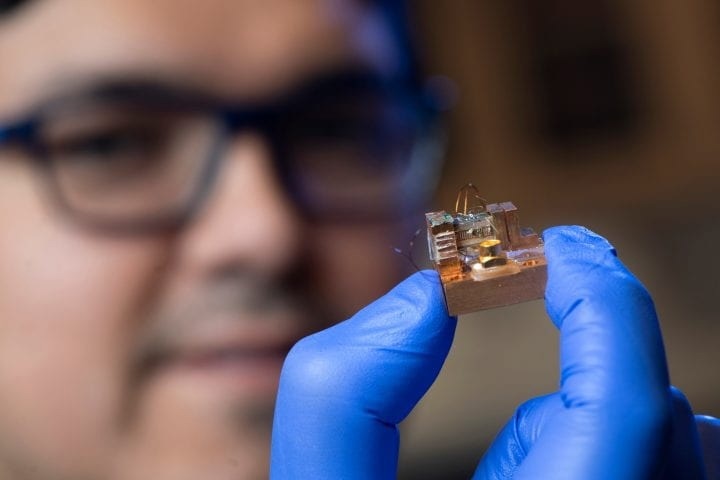In the most recent issue of Nature Communications, researchers from Los Alamos National Laboratory and the University of California, Irvine, detail how they discovered a novel technique that turns common materials like glass into materials that could be used to create quantum computers.
 A “bending station,” a device crafted in the laboratory of Luis Jaurequi, UCI professor of physics and astronomy, can change the electrical characteristics of materials at the atomic scale. Image Credit: Steve Zylius / UCI
A “bending station,” a device crafted in the laboratory of Luis Jaurequi, UCI professor of physics and astronomy, can change the electrical characteristics of materials at the atomic scale. Image Credit: Steve Zylius / UCI
The materials we made are substances that exhibit unique electrical or quantum properties because of their specific atomic shapes or structures. Imagine if we could transform glass, typically considered an insulating material, and convert it into efficient conductors akin to copper. That is what we have done.
Luis A. Jauregui, Study Lead Author and Professor, Physics & Astronomy, University of California, Irvine
Silicon is a conductor used in conventional computers, although it has limitations. These limitations could be overcome with quantum computers, and techniques such as those outlined in the recent study will make quantum computing a practical reality.
Jauregui added, “This experiment is based on the unique capabilities that we have at UCI for growing high-quality quantum materials. How can we transform these materials that are poor conductors into good conductors? That is what we have done in this paper. We have been applying new techniques to these materials, and we’ve transformed them to being good conductors.”
Applying the proper type of strain to materials at the atomic scale was crucial, according to Jauregui. To achieve this, the group created a unique device known as a “bending station” at the UCI School of Physical Sciences machine shop.
This device enabled them to apply significant strain and transform the atomic structure of a substance known as hafnium pentatelluride from a “trivial” substance into one suitable for use in quantum computing.
“To create such materials, we need to ‘poke holes’ in the atomic structure. Strain allows us to do that,” Jauregui added.
Jinyu Liu, who is the study's first author and a postdoctoral scholar working with Jauregui further added, “You can also turn the atomic structure change on or off by controlling the strain, which is useful if you want to create an on-off switch for the material in a quantum computer in the future.”
“I am pleased by the way theoretical simulations offer profound insights into experimental observations, thereby accelerating the discovery of methods for controlling the quantum states of novel materials. This underscores the success of collaborative efforts involving diverse expertise in frontier research,” stated study co-author Ruqian Wu, Professor of Physics and Associate Director of the UCI Center for Complex and Active Materials – a National Science Foundation Materials Research Science and Engineering Center (MRSEC).
Michael Pettes, study co-author and scientist with the Center for Integrated Nanotechnologies at Los Alamos National Laboratory, noted, “I am excited that our team was able to show that these elusive and much-sought-after material states can be made. This is promising for the development of quantum devices, and the methodology we demonstrate is compatible for experimentation on other quantum materials as well.”
There are currently just a few locations with quantum technology, including the offices of IBM, Google, and Rigetti.
Jauregui added, “Google, IBM and many other companies are looking for effective quantum computers that we can use in our daily lives. Our hope is that this new research helps make the promise of quantum computers more of a reality.”
Funding was provided by the Los Alamos National Laboratory Directed Research and Development Directed Research program and the UCI-MRSEC, an NSF CAREER grant to Jauregui.
Robert Welser, Sebastian Yepez Rodriguez, Matthew Delmont, Triet Ho, and other graduate and undergraduate students from UCI took part in this study.
Journal Reference:
Liu, J., et. al. (2024) Controllable strain-driven topological phase transition and dominant surface-state transport in HfTe5. Nature Communications. doi:10.1038/s41467-023-44547-7